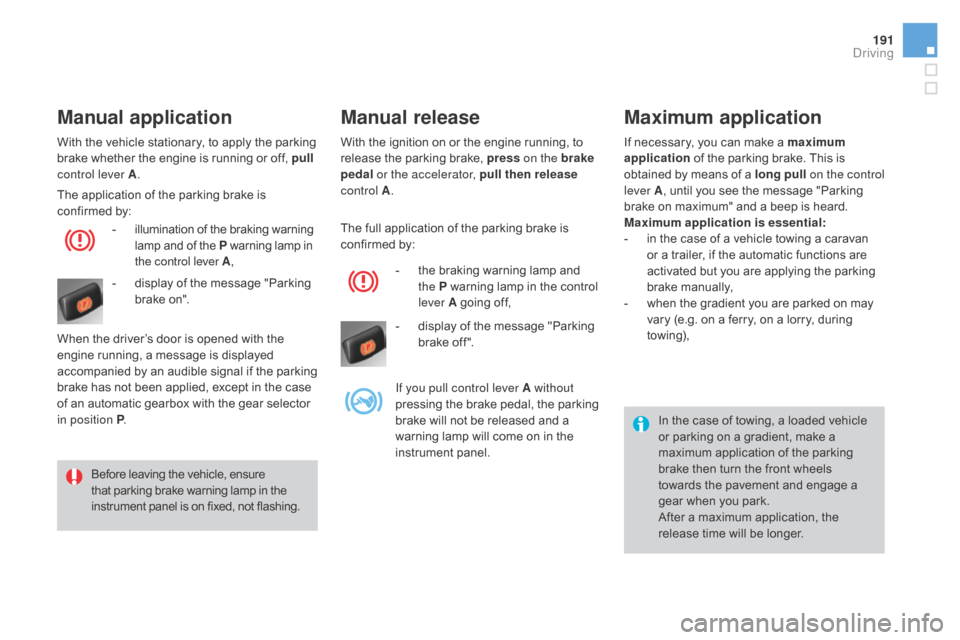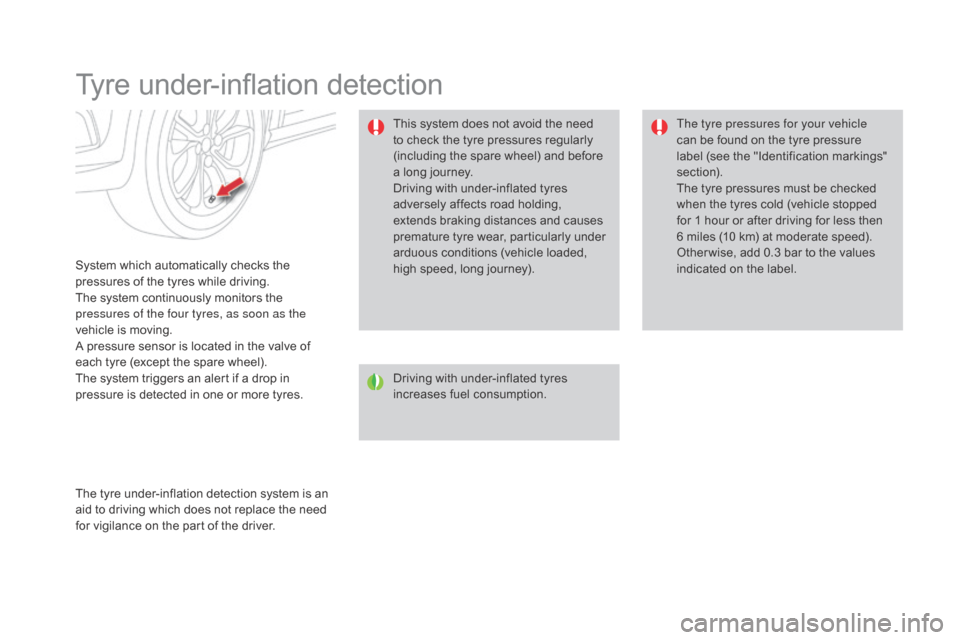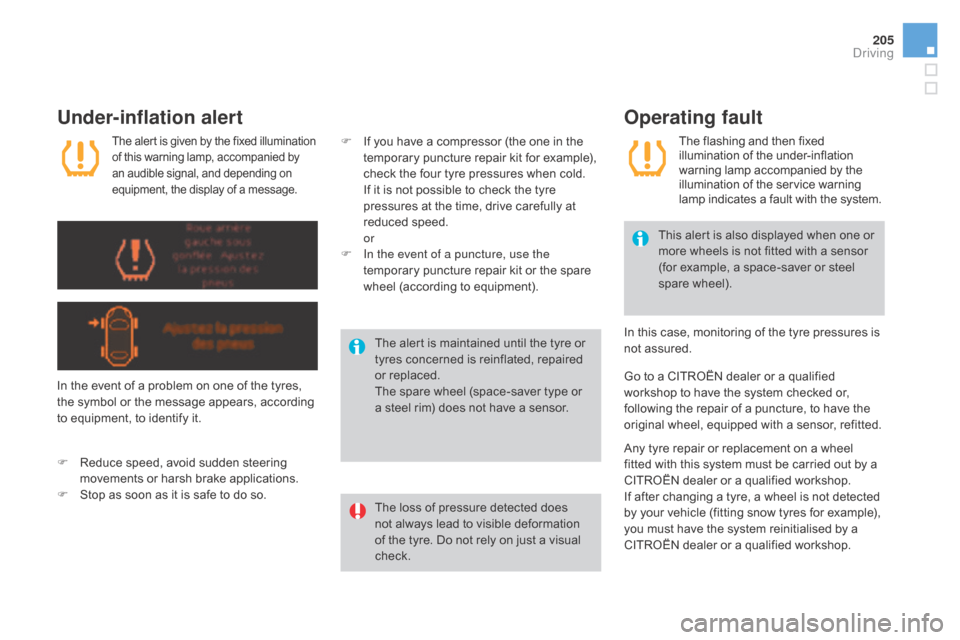wheel Citroen DS4 RHD 2015.5 1.G Owner's Guide
[x] Cancel search | Manufacturer: CITROEN, Model Year: 2015.5, Model line: DS4 RHD, Model: Citroen DS4 RHD 2015.5 1.GPages: 436, PDF Size: 10.13 MB
Page 189 of 436

187
Starting / Switching off the engine with Keyless Entry and
Starting
Starting the engine
F Place the gear selector lever P or n with
an automatic gearbox, or neutral with a
manual gearbox.
F
W
ith the electronic key inside the vehicle,
press the brake pedal for vehicles with an
automatic gearbox, or fully declutch for
vehicles with a manual gearbox. F
B
riefly press the "
S TA R T/
STOP " button while maintaining
pressure on the pedal until the
engine starts. If the electronic key is not detected
in the zone, a message is displayed.
Move the electronic key into the zone
so that the engine can be started.
If one of the starting conditions is not
met, a reminder message appears in
the instrument panel screen. In some
circumstances, it is necessary to
turn the steering wheel slightly while
pressing the " START/STOP " button
to assist unlocking of the steering;
a message warns you when this is
needed.
The presence of the "Keyless Entry
and Starting" electronic key in the
recognition zone is essential.
As a safety measure, do not leave this
zone with the vehicle running.
diesel vehicles
In temperatures below zero
the engine will not start until
the preheater warning lamp
has gone off.
If this warning lamp comes on after
pressing " START/STOP ", you should
hold the brake or clutch pedal down
until the warning lamp goes off and do
not press the " START/STOP" button
again.
The steering column unlocks and the engine
starts more or less instantly.
See the advice below for Diesel versions.
It is not necessary to place the electronic key in
the reader.
driving
Page 193 of 436

191
With the ignition on or the engine running, to
release the parking brake, press on the brake
pedal or the accelerator, pull then release
control A .
Manual release
Before leaving the vehicle, ensure
that parking brake warning lamp in the
instrument panel is on fixed, not flashing.
Manual application
With the vehicle stationary, to apply the parking
brake whether the engine is running or off, pull
control lever A .
The application of the parking brake is
confirmed by: -
i
llumination of the braking warning
lamp and of the P warning lamp in
the control lever A ,
-
d
isplay of the message "Parking
brake on".
When the driver’s door is opened with the
engine running, a message is displayed
accompanied by an audible signal if the parking
brake has not been applied, except in the case
of an automatic gearbox with the gear selector
in position P . The full application of the parking brake is
confirmed by:
-
t
he braking warning lamp and
the P warning lamp in the control
lever A going off,
-
d
isplay of the message "Parking
brake off ".
If you pull control lever A without
pressing the brake pedal, the parking
brake will not be released and a
warning lamp will come on in the
instrument panel.
Maximum application
If necessary, you can make a maximum
application of the parking brake. This is
obtained by means of a long pull on the control
lever A , until you see the message "Parking
brake on maximum" and a beep is heard.
Maximum application is essential:
-
i
n the case of a vehicle towing a caravan
or a trailer, if the automatic functions are
activated but you are applying the parking
brake manually,
-
w
hen the gradient you are parked on may
vary (e.g. on a ferry, on a lorry, during
towing),
In the case of towing, a loaded vehicle
or parking on a gradient, make a
maximum application of the parking
brake then turn the front wheels
towards the pavement and engage a
gear when you park.
After a maximum application, the
release time will be longer.
driving
Page 194 of 436

With the vehicle stationary, the parking brake
is automatically applied when the engine is
switched off.
Automatic application,
engine off
In the case of towing, a loaded vehicle
or parking on a gradient, turn the front
wheels towards the pavement and
engage a gear when you park. Before leaving the vehicle, ensure
that parking brake warning lamp in
the instrument panel is on fixed (not
flashing).
Never leave a child alone inside the
vehicle with the ignition on, as they
could release the parking brake.
-
i
llumination of the braking warning
lamp and of the P warning lamp in
the control lever A ,
-
d
isplay of the message "Parking
brake on".
The application of the parking brake is
confirmed by:
Automatic release
The electric parking brake releases
automatically and progressively
when you
press the accelerator:
F
M
anual gearbox: press down fully on the
clutch pedal, engage first gear or reverse,
press on the accelerator pedal and
move
off.
F
A
utomatic gearbox: select position
d
,
M
or R then press the accelerator pedal.
When stationary, with the engine running, do
not press the accelerator pedal unnecessarily,
as you may release the parking brake.
Full release of the parking brake is
confirmed by:
-
t
he braking warning lamp and
the P warning lamp in the control
lever A going off,
-
d
isplay of the message "Parking
brake off ".
Page 197 of 436

195
SituationsConsequences
To apply the electric parking brake:
F
i
mmobilise the vehicle and switch off the ignition.
F
p
ull the control for at least 5 seconds or until application is complete.
F
s
witch on the ignition and check the switching on of the electric parking brake
warning lamps.
The application is slower than during normal operation.
To release the electric parking brake:
F
s
witch on the ignition.
F
p
ull the control and hold it for approximately 3 seconds then release it.
If the braking warning lamp is flashing or if the warning lamps do not come on with
the ignition on, these procedures will not work. Place the vehicle on level ground
and have it checked by a CITROËN dealer or a qualified workshop.
and possibly
flashing
Display of the message "
Parking brake fault" and of the
following warning lamps: -
O
nly the automatic application on switching off the engine and automatic
release on acceleration functions are available.
-
T
he manual application/release of the electric parking brake and the
emergency braking are not available.
and possibly
flashing
Battery fault -
I
f the battery warning lamp comes on you must stop immediately as soon as
the traffic allows. Stop and immobilise your vehicle (if necessary, place the
two chocks under the wheels).
-
A
pply the electric parking brake before switching off the engine.
driving
Page 198 of 436

Manual parking brake
Applying
F Pull the parking brake lever fully up to immobilise your vehicle.
Releasing
F Pull the parking brake lever up gently, press the release button then lower the
lever fully. When parking on a slope, direct your
wheels against the kerb, apply the
parking brake, engage a gear and
switch off the ignition.
When the vehicle is being driven,
if this warning lamp and the STOP
warning lamp come on, accompanied
by an audible signal and a message in the
multifunction screen, this indicates that the
parking brake is still on or has not been
properly released.
Page 206 of 436

Tyre under-inflation detection
System which automatically checks the
pressures of the tyres while driving.
The system continuously monitors the
pressures of the four tyres, as soon as the
vehicle is moving.
A pressure sensor is located in the valve of
each tyre (except the spare wheel).
The system triggers an alert if a drop in
pressure is detected in one or more tyres.Driving with under-inflated tyres
increases fuel consumption.The tyre pressures for your vehicle
can be found on the tyre pressure
label (see the "Identification markings"
section).
The tyre pressures must be checked
when the tyres cold (vehicle stopped
for 1 hour or after driving for less then
6 miles (10 km) at moderate speed).
Other wise, add 0.3 bar to the values
indicated on the label.
This system does not avoid the need
to check the tyre pressures regularly
(including the spare wheel) and before
a long journey.
Driving with under-inflated tyres
adversely affects road holding,
extends braking distances and causes
premature tyre wear, particularly under
arduous conditions (vehicle loaded,
high speed, long journey).
The tyre under-inflation detection system is an
aid to driving which does not replace the need
for vigilance on the part of the driver.
Page 207 of 436

205
Under-inflation alert
The loss of pressure detected does
not always lead to visible deformation
of the tyre. Do not rely on just a visual
check.This alert is also displayed when one or
more wheels is not fitted with a sensor
(for example, a space-saver or steel
spare wheel).
The alert is maintained until the tyre or
tyres concerned is reinflated, repaired
or replaced.
The spare wheel (space-saver type or
a steel rim) does not have a sensor.
The alert is given by the fixed illumination
of this warning lamp, accompanied by
an audible signal, and depending on
equipment, the display of a message.
In the event of a problem on one of the tyres,
the symbol or the message appears, according
to equipment, to identify it.
F
R
educe speed, avoid sudden steering
movements or harsh brake applications.
F
S
top as soon as it is safe to do so.
Operating fault
The flashing and then fixed
illumination of the under-inflation
warning lamp accompanied by the
illumination of the service warning
lamp indicates a fault with the system.
Go to a CITROËN dealer or a qualified
workshop
to have the system checked or,
following the repair of a puncture, to have the
original wheel, equipped with a sensor, refitted.
F
I
f you have a compressor (the one in the
temporary puncture repair kit for example),
check the four tyre pressures when cold.
I
f it is not possible to check the tyre
pressures at the time, drive carefully at
reduced speed.
or
F
I
n the event of a puncture, use the
temporary puncture repair kit or the spare
wheel (according to equipment).
Any tyre repair or replacement on a wheel
fitted with this system must be carried out by a
CITROËN dealer or a qualified workshop.
If after changing a tyre, a wheel is not detected
by your vehicle (fitting snow tyres for example),
you must have the system reinitialised by a
CITROËN dealer or a qualified workshop. In this case, monitoring of the tyre pressures is
not assured.
driving
Page 217 of 436

215
System which prevents the vehicle from exceeding the speed programmed by the driver.
Speed limiter
The speed limiter is a driving aid that
cannot, in any circumstances, replace the
need to observe speed limits or the need
for vigilance on the part of the driver.1.
S
peed limiter mode selection wheel.
2.
P
rogrammed value decrease button.
3.
P
rogrammed value increase button.
4.
S
peed limiter on / pause button.
5.
D
isplay memorised speed settings button.
Steering mounted controls
6. Speed limiter on / pause indication.
7. S
peed limiter mode selection indication.
8.
P
rogrammed speed value.
9.
S
election of a memorised speed setting.
displays in the instrument panel
The speed limiter is switched on manually.
The minimum programmed speed is
20
mph (30 km/h).
The programmed speed remains in the
system memory when the ignition is
switched off.
driving
Page 218 of 436

Switching on
F Turn the wheel 1 to the "LIMIT" position
to select the speed limiter; the function is
paused.
F
I
f the speed setting is suitable (last speed
setting programmed in the system) press
button 4 to switch the speed limiter on.
F
P
ressing button 4 temporarily interrupts the
function (pause).
Adjusting the limit speed
setting
You do not have to switch the speed limiter on
in order to set the speed. To modify the limit speed setting from the
current speed of the vehicle:
F
i
n steps of +/- 1 mph (km/h), make
successive short presses on button 2 or 3 ,
F
c
ontinuously, in steps of +/- 5 mph (km/h),
press and hold button 2 or 3 .
To modify the limit speed setting using
memorised speeds and from your Audio
system:
F
w
ith the system first activated (see
"Memorising speeds"),
F
m
ake a long press on button 2 or 3 , the
system displays the memorised speed
closest to the actual speed of the vehicle;
this setting becomes the new limit speed,
F
t
o choose another memorised speed, make
another long press on button 2 or 3.
To modify the limit speed setting using
memorised speeds and from the touch screen
tablet:
F
p
ress button 5 to display the six memorised
speed settings,
F
p
ress the button for the desired speed
setting.
This setting becomes the new limit speed.
Page 219 of 436

217
On a steep descent or in the event of
sharp acceleration, the speed limiter will
not be able to prevent the vehicle from
exceeding the programmed speed.The use of mats not approved by
CITROËN may inter fere with the
operation of the speed limiter.
To avoid any risk of jamming of the
pedals:
-
e
nsure that the mat is positioned
c o r r e c t l y,
-
d
o not fit one mat on top of another.
Temporarily exceeding the
programmed speed
F If you want to temporarily exceed the programmed limit speed, press firmly on
the accelerator pedal, going beyond the
point of resistance .
The speed limiter is deactivated temporarily
and the displayed programmed speed flashes. When the limit speed is exceeded but is not
due to action by the driver, there is an audible
signal to complete the alert.
Once the speed of the vehicle returns to
the programmed setting, the speed limiter
functions again: the display of the programmed
speed setting becomes steady again.
Switching off
F Turn wheel 1 to the "0"
position: the
display of information on the speed limiter
disappears.
Operating fault
Flashing dashes indicate a fault with the speed
limiter.
Have it checked by a CITROËN dealer or a
qualified workshop.
driving